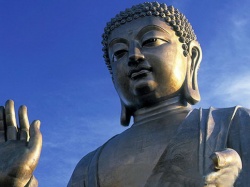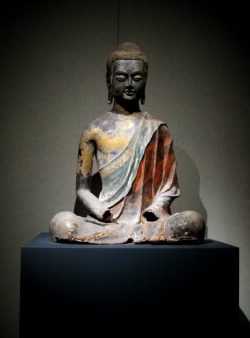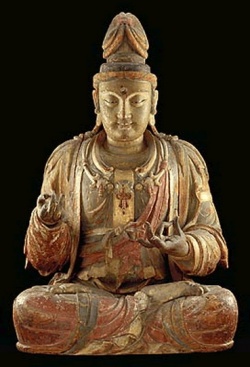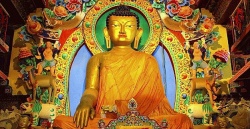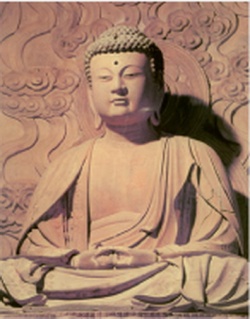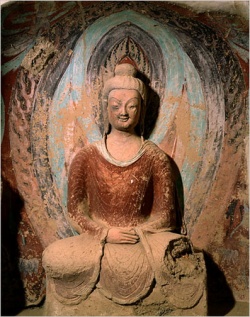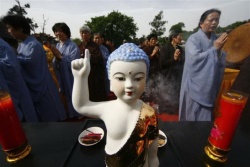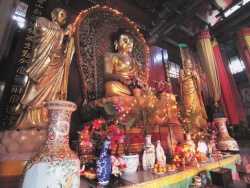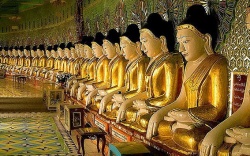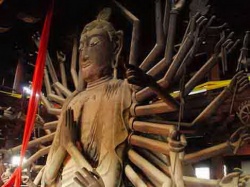From India to China: Transformations in Buddhist Philosophy
In a sense, Buddhism never was accepted in China. At least not in its purely Indian form. Legends abound about Indians such as Bodhidharma introducing various forms of Buddhism to China , but these tales tell us little about the gradual textural changes which result when the yeast of a foreign view of being penetrates and permeates the life of a nation as already rich and diversified as medieval China .
Buddhism didn't march into China with the entourage of the 28th Patriarch , but rather trickled in---the way most ideologies with staying power latch themselves to the minds and imaginations of a people. Much of this trickling occurred during the time of Emperor Ming (68-75 C.E.). By 200 A.D., Chinese translations of Buddhist scriptures were beginning to appear.[1]
There are certain characteristics of Indian Buddhism , moreover, which were abhorrent, or at least incomprehensible, to the practical Chinese mind . With its tradition of asceticism inherited from Hindu thought , the Indian Buddhist could easily embrace the kind of deferred gratification prescribed in meditation (meditate and fast moderately now; attain Nirvana later).
The Chinese , immersed in a tradition which celebrated hard work and a satisfying life of the senses ---including the sense of humor---undoubtedly chuckled at this and other attitudes and practices which seemed other-worldly and irrelevant to day-to-day life . But being a practical people, many also could see some compelling ideas and qualities in Buddhism with value for their lives as individuals and a society.
Cultural Differences Between China and India
Until the 20th century, Buddhism was the only religion assimilated into Chinese civilization. Chinese philosophy ---before and since the advent of Buddhism ---crystallized between 250 and 600 A.D. in Confucianism and Taoism, with their emphasis on practical matters, such as family, civic duty, harmoniousness and concord with the natural order. One of the factors shaping the formulation of Chinese thought before Buddhism was the nature and structure of the Chinese language .
As the characteristics of the Greek language gave Socrates , Plato and Aristotle the tools to think in terms of general philosophical concepts ("the Good," for example) and dialectical technique, so the qualities of ancient Chinese , with its emphasis on the particular rather than the general and its conduciveness to harmonious resolution rather than debate , helped shape the kinds of thinking which took place in China thousands of years ago up until our time. Nakamura demonstrates the concreteness of Chinese language by pointing out that Chinese for universe or cosmos is expressed as shan, ho, ta-ti, "mountains, rivers and the great earth ." The expression for human ego, ts'ao-yuan i-ti-shui , literally is translated as "the wind and light of one's native place."[2] Abstract thought dealing with generalities and overall concepts does not come readily to those whose vocabulary is so individualized and particular.
Translators from Chinese into English often comment on the "ambiguity" of the Chinese language , how one character can have many meanings which can only be inferred from its relationship to other characters within a sentence. When, as in our time, ideas from a more intuitive language (Chinese ) are introduced into a culture dominated by a more rational language (English), a rich amplification of consciousness can occur. People find new ways of looking at old problems and expand the circle of their thought processes. Just such an enrichment of consciousness occurred in reverse in China when Buddhist thought , conveyed through the logical -specific language of Indian Sanskrit (the root of Western language and abstract thought ), entered its intuitive mental culture.
Indian and Chinese thought and culture were divided by more than language. Language mirrors and expresses the ideas, attitudes and even social conventions of a people. In the down-to-earth pictographs of the Chinese language , where every word-symbol has a highly specific and individualized meaning (e.g., a pictograph depicting a man standing in a house is the word-symbol for "man"), there is no place for metaphysical abstractions. Because the Chinese lived (philosophically) in the here and now and had little concern with ideas focused on the possible hereafter, their language developed with a singular shortage of word-symbols to express ideas of existence beyond the reality perceived through the senses . The most highly esteemed early Indian thinkers (anonymous sages who speculated within a religious consciousness ), however, expressed the opinion that life was suffering and a sort of test or ironic game of Brahma . Like the extreme Christian fundamentalist of today, they thought and believed that life truly begins with death and that the senses are deceivers which mislead people into a path leading to the Indian version of hell (eternal rebirth into the world of sorrows until enlightenment frees them from their torments). This attitude shaped the development of the Sanskrit and related Indian tongues with the result that Indian language teems with words dealing with philosophical and religious abstractions Even today, yoga students use such classical Indian terms as samsara, maya, atman and many others, simply because they connote these abstractions better than any other language .
Another difference between Indian and Chinese language lies in the way ideas are expressed. Nakamura states that Indians are more likely to make abstract ideas the subject of a sentence or entire essay. The Chinese , on the other hand, usually make man the subject. (This provides an interesting contrast with Chinese art, where man is portrayed as only a very small part of a larger natural context; however, he is always conspicuous even if his presence is small--or perhaps because he is small--and, in this sense , may be said to be the subject of the artwork as well). Chinese would translate the Indian phrase, "Therefore, the sufferings accompany him," as, "Therefore, he endured various sufferings ."[3] While the Indian original employs the passive voice , the Chinese uses the active. The Indian sees man's role within the context of a larger, abstract whole; the Chinese interprets everything from a personal point of view. "Influenced by this way of considering all things anthropocentrically, most Chinese were apt to be utilitarian and pragmatic," wrote Nakamara. "In this respect their way of thinking has been different from that of most European scholastic and idealistic philosophers "[4] who owe their language and philosophical method to Indian roots.
Indian and Chinese thought also divide in their use of logic , one of the most highly esteemed tools of philosophy in the West. Despite the intensity of popular, fundamentalist religious practices, major Indian thinkers did not consider sacred scriptures, sutras by famous men and traditions a reliable source of truth . Hsuan-tsang introduced one of the later schools of Indian logical thought (new Hetu-vidya ) into China . This school accepted reason alone as the only authority, and acknowledged only the processes of inference (anumana ) and sense (pratyaksa ) as the basis for forming knowledge .[5] However, this approach did not take root in China because of the high regard its thinkers had for traditional knowledge and known authorities.
The differences between Indian and Chinese culture and methods of thinking and communicating also extend to visual symbols . In Indian and Greek thought , the sphere--a three-dimensional embodiment of harmony --was the preferred symbol for the perfect expression of reality.[6] According to Vaisesika philosophy , the building blocks of the universe ("atoms") were believed to be globular. Indian thinkers also considered the wheel to be a symbol of perfect reality , which accounts for the creation of huge stone juggernauts rolled ominously and symbolically through villages and cities. Here, the idea of motion was inherent in the symbolism of the wheel . Life was a wheel , in a sense , as human life rolls from birth to death to rebirth over countless incarnations .
Chinese thinkers, however, once again revealed a different dimensionality in their thought processes. While the Indian symbol of perfect reality is three-dimensional and kinetic, the Chinese symbol , the circle, appears flat and stationary to the casual observer. Once Buddhism was imported into sections of China , the famous oxherding pictures developed, symbolizing man's evolution from unenlightened being (the farmer who does not have his ox) to the enlightened sage (man who has successfully searched for and found his ox). In this series of pictures, a circle is the final image, signifying perfect emptiness (not in the Western sense of barrenness, but rather to suggest ineffability). The circle appears throughout Chinese culture in many important contexts, such as the unit of the yin/yang icon.
Another difference in graphic expression of intellectual concepts lies in the realm of didactic diagrams. With a subtle Sanskrit vocabulary deftly dealing with abstractions, India had no need of the precise, particular visual aids which Chinese thinkers used to communicate ideas.
Chinese thinkers traditionally relied on diagrams to both express and teach, such as the use of the circle of eight trigrams which form the 64 hexagrams of the I Ching (a Taoist sourcebook which has absorbed the attention of Chinese thinkers through the present day, and was adapted to a Buddhist interpretation shortly after the new philosophy penetrated China ). Other examples of the use of didactic diagrams and illustrations are the Zen ox-herding pictures and the use of white and black-filled circles (and a complex network of interconnecting symbols and ideographs) to describe polarities in the philosophical writings of Feng-kuei Tsung-mi (780-841), a scholar who attempted to explain what he saw as the relationships between pure and impure mind (cited by Nakamura ).
All of this points to the importance of concrete examples, particularity and individualism in Chinese thought and culture, as contrasted with the Indian model. This is important in our consideration of the way Buddhism changed Chinese thought , but also in the way that Chinese interpretation of Buddhist ideas and symbols changed some of the concepts of Buddhism .
Buddhist Ideas in India
As it developed in India , Buddhism was a rational evolution emerging from the context of Hindu (Vedantist) religion -philosophy . On the religious level, Buddhism accepted the Vedic posture that sense-based life is suffering and must be transcended to experience a higher state of realization , one's "own true nature," as it is frequently referred to in scriptures of both traditions . It differed from Hinduism , however, on a number of important points, some religious (use of rites, moral precepts, definition of God), and some philosophical .
Despite the highly charged emotionality of much that we associate with Hinduism (colorful festivals, charismatic fakirs and gurus , ecstasies and spectacular mortifications), a rational process of abstract thought , articulated by philosophers within the Vedic context, underpins this rich and ancient tradition . Brahman , the essence of being, is synonymous with atman , the inner light or "god -within." Men and women are suppressed in the material world of samsara and destined to journey through an eternity of rebirths via the law of karma unless they can achieve samadhi (enlightenment ). One who would transcend the world of pain, pleasure and distraction to experience total identity with the Absolute must follow a rational program of meditation , austerities and good works. Within the tradition , there was ample room for redefinition of ideas, debate and the development of schools of thought as well as the emergence of individual thinkers such as Patanjali and Shankara.
As Hinduism became enmeshed with the cultural life of India , however, even its most esoteric protagonists became distracted from its original concepts and their subsequent development, according to some critics of the time. Ritual de-evolved into magic shows, and austerities undertaken to remove distractions from the spiritual and intellectual quest became in themselves distractions, as renunciants became fixated on states of discomfort and starvation. It was during a period of calm reflection away from these mortifications that the monk Gautama Siddhartha became flooded with insight and developed a less colorful, but more intellectual approach to the pursuit of truth which we call Buddhism.
One of the most appealing premises of Buddhism to Western thinkers is its emphasis on individual exploration, deliberation, debate and practice. According to the Buddha himself, enlightenment (however we choose to interpret it--whether a high state of understanding or a genuine mystical experience of ultimate reality ) cannot be reached by a team effort. Ultimately, it is one man or woman working alone who can uncover the path to truth . Buddha reportedly said, "Accept my words only after you have examined them for yourselves; do not accept them simply because of the reverence you have for me."[7] It was just this emphasis on individual action and practical rewards in the here and now which greatly appealed to many Chinese once the philosophy crossed their borders. This idiosyncratic quality was developed in China (where it became the Mahayana school) far beyond the direction it took in Southern climates (the Theravada school).
The philosophy of Buddhism developed in various forms in India in accordance with certain basic tenets, most notably the Four Noble Truths and Eightfold Path .
The Four Noble Truths are as follows:
- 1. That suffering exists.
- 2. There is a cause to suffering .
- 3. Suffering can cease.
- 4. There is a path which leads to permanent cessation of suffering .
It is interesting to note an important distinction. Buddhism holds that life is suffering , not evil , such as some of the Hindu pandits of the time proclaimed. Suzuki claimed that Mahayana Buddhism (the variety which was accepted in China ) was the "first...teaching in India that contradicted the doctrine of Nirvana as conceived by other Hindu thinkers. The Nirvana of the Hindu yogis was a complete annihilation of being, for they thought that existence is evil , and evil is misery, and the only way to escape misery is to destroy the root of existence, which is nothing less than the total cessation of human desires and activities in Nirvanic unconsciousness."[8] This is a point of view antithetical to Chinese thought . It is also a point of view which betrays Suzuki's own bias against Hindu thought ; Paramahansa Yogananda, for example, a highly regarded yogi of the 20th century, said existence was not evil , but the play or game of God . This view is sustained in the Vedas and Bhagavad Gita, seminal texts of Hinduism . While undoubtedly some schools of Hindu thought advocated cessation of thought and lethal mortifications to escape from an evil world , others believed that human life is the greatest possible blessing because it is only through this level of incarnation that one can rise to an understanding and experience of Ultimate Reality , or what Plato would call the Good.
Suzuki believed that unlike other Hindu teachers, Buddha did not teach that Nirvana (complete awareness ) could be achieved through the complete cessation of existence as we commonly know it. The way to conquer suffering and attain Nirvana is outlined in the Eightfold Path , which holds that one must develop "right" understanding, thought or motives, speech , action, means of livelihood , effort, mindfulness and concentration . These concepts are abstract enough to inspire many contrasting canons of philosophical speculation within southern schools of Buddhism and yet specific enough to promote (at the very least) a certain level of ethical [9] commitment or behavior in anyone who claimed to follow the Buddha's way. Underlying these precepts are injunctions to mindfulness and compassion which adds warmth through personalization and concern for others, making the Path more than a cold "laundry list" of required commandments. Although the Eightfold Path was introduced as a radical departure from Hindu ethics, it is not really so different from the eight kriyas of orthodox Hindu thought : yama , noninjury to others, trustfulness, nonstealing, continence and noncovetousness; niyama, purity of body and mind , contentment , self -discipline , self -study and devotion; asana, right posture ; pranayama, control of the breath and subtle life currents; pratyahara, withdrawal of senses from external objects; dharana, keeping the mind focused on a thought or object; dhyana , meditation ; and samadhi , superconscious experience. Only the hatha yoga admonitions on right posture and breath are not among the precepts of the Eightfold Path ; and yet both play an important role in Buddhist practices of all schools.
Saddhatissa states that Buddhism has been described in three short axioms: cease to do evil , learn to do good, purify your own mind.[10] These axioms and the Eightfold Path may have set the moral parameters for Buddhism , but clearly do not constitute Buddhist practice or philosophy --just as the Ten Commandments and the Golden Rule do not constitute [[Wikipedia:Christianity|Christianity]].
These suggestions for "better living through Buddhism " provide a context in which true reflection--the essence of Buddhism --and its consequences, whatever they may be, can occur. To use a simile which appears throughout Buddhist literature, when a man points to the heavens, we should not mistake his finger for the moon. Chinese thinkers, with their suspicion of generalizations and rigid religious dogma, were especially attracted to the idea that the doctrine (Dharma ) and rules of conduct were not in themselves the end, but rather practical guides to help individuals achieve their highest potential.
Partly because of resistance in staunchly Hindu India , Buddhism began to spread northward into China in the centuries immediately following Buddha 's death . It certainly was not met with open arms, but managed to find a niche in southern China by the first and second century by gradually adapting itself to Chinese attitudes and customs. The earthy Chinese were especially suspect of any philosophy emanating from a country whose prevailing philosophy of life was diametrically opposed to their idea of common sense (e.g., one which taught mortification in this life , happiness in the next). Nonetheless, if the Chinese had had opportunity to really observe their Indian neighbors, with their rich family life , colorful feasts and piquant cuisine, they would have realized that India had no shortage of joie de vie either.
Had the Chinese represented a united front, with a peaceful political climate and consistency in religion , ideas and culture, Buddhism may have had a more difficult time making itself known. However, during the Han and T'ang dynasties (approximately 250 to 600 C.E.), Buddhist ideas benefited from an unequaled state of instability and uncertainty, just the sort of environment which welcomes a point of view which admits that life is tough and that there is a way to overcome it, at least on a personal level. With the proliferation of short-lived states, disillusionment with Confucianism , widespread anarchy and invasions by non-Chinese in the north, Buddhism made major inroads into China , provided it adapted itself along the way. It was an immigration which included the appearance in the sixth century of the 28th Ch'an patriarch , Bodhidharma , (Ch'an became Zen when transported to Japan ) and in thousands of less well-remembered monks who, without overt proselytizing, communicated an alternative way of living and thinking to men and women looking for a new answer to ancient concerns.
Chinese Forms of Buddhism : Mahayana and Zen
In whichever form it appeared (Mahayana or Zen ), Buddhism in China took on a very different cast from its expression in India . Part of this is due to the Chinese way with words. Chinese scholars were quick to translate the sutras into their native tongue before 200 C.E., but not without reflecting certain national idiosyncrasies.
Interpreting the Dharma to fit Chinese culture
According to Nakamura , Chinese scholars have a predilection for specificity in literature, history and philosophy . So much so, in fact, that if specificity is lacking, they will provide the needed details by inventing them. This even applies to mythological figures, who are often placed in exact historical contexts, a process called, euhemerism. (E.g., the Buddhist divinity Yama , King of Hell , became literally identified with a Sui dynasty official who died in 592 C.E., according to Arthur F. Wright, Buddhism in Chinese History.)
The existence of so many detailed descriptions of what the Buddha said to whom in Chinese translations of sutras is no proof that Buddha actually said or did any of these things. Rather, it is proof of the boundless imagination , compulsiveness and creativity of the Chinese in painstakingly making up history to accord with their definition of what a worthy scripture should be[11] (at least, in Nakamura 's opinion). " China 's classical conservative ways of thinking modified the form of its reception of Buddhism ," Nakamura writes. "Chinese Buddhists ...took over the doctrine founded and taught by Sakyamuni , and considered it their duty to exalt their interpretation of his teaching, in spite of the fact that Chinese Buddhism differs from Indian Buddhism in many respects. Therefore, they rewrote arbitrarily even the sentences of the sutra ."
Nakamura cites an example in which a tenet is expressed "just the opposite of its original meaning": the original in the Fa Hua Ching states, "An enlightened self opened his eyes to the Truth without looking to his master for help," while the Chinese translation reads, "he listened to the Buddha 's law (which is, of course, "looking to his master for help") and accepted it as being true. "
In their search for historical sources of authority for every idea, scholars routinely poured new philosophical wine into old pedagogical wineskins, making sure to backdate, classify, code and make precise-sounding attributions. This was not through a desire to deceive, but to provide continuity and order, two of the governing principles of all Chinese life . This compulsiveness about specificity applied to both Mahayana and Zen throughout their long history in China .
Once the scriptures were properly coded, classified and "Sinologized," many Chinese were ready for the ideas of Mahayana Buddhism . One of its appeals during its period of greatest acceptance was the promise of a higher life beyond the suffering of the present, something which neither Confucianism with its veneration of family lineage , and Taoism, with its cheerful stoicism and vague nature-worship, could not provide. Unlike the Theravada school popular in southern Asia , however, Mahayana Buddhism placed less emphasis on personal salvation and more focus on helping others achieve the goal of liberation . While the Buddhist was likely to become a self -focused renunciant and pursue personal realization , the Mahayanist was enjoined to defer spiritual gratification until "all sentient beings " were liberated. This led to the ideal of the bodhisattva , the saint who comes to the threshold of Nirvana and proceeds no further, accepting reincarnation in the world until others experience freedom. Although this is usually presented in a religious context, I like to think that it applies to the world of ideas as well, both religion and philosophy being inextricably intertwined in Asian thought and experience. Bodhisattvic philosophers would not be content with thinking things through for themselves; they wouldn't rest until their students, too, were well on their way to understanding.
Because Buddhism was a foreign influence, however, and everything "barbarian" was suspect, certain Chinese critics were jolted out of complacency by the spread of the dharma . An invigorating side-effect of the advent of Buddhism was this critical reaction among many scholars , who were forced into the position of challenging new ideas and defending their long-held position, much in the spirit of Indian and Western dialectic . According to Mather, Nirvana lay entirely outside the realm of traditional Chinese ideas of reality.[12] Chinese thinkers had long been appalled by the (inferior) Indian position that the sensual world and its operating principle (the Tao ) were "mere illusion ," not to mention downright evil . In the first four centuries of the Christian Era, this barbarian influence was infiltrating China just when it was least politically stable and more vulnerable to sedition. As the philosophy and practice infiltrated society, many traditionalists banded together to stop the foreign influence, not so much out of intolerance (an attitude flatly rejected by both Taoism and Confucianism ), but because they felt that the Chinese world view was being turned upside down. Any time people's entrenched ideas are threatened...no matter how basically sound those ideas may be, it is like a "shot in the arm" for tired thoughts , providing a tonic which invigorates, freshens and inspires new ways of thinking . This was one of Buddhism 's chief contributions to Chinese thought .
Several other adaptations occurred as Mahayana Buddhism crossed the Chinese borders. As the ancient Romans knew and demonstrated in their many conquests, new ideas are more readily accepted if they are presented in the language and culture of the foreign host. When not in Rome , one could say, do as the non-Romans do. Certainly, Mahayana Buddhism as strictly interpreted in India would not have fared well in China without assuming certain Chinese characteristics. Some of these were ritualistic and religious rather than philosophical , such as the introduction of spells and charms.
Nakamura clearly prefers the Indian form of Buddhism with its emphasis on abstract ideas and uses the incorporation of magical phrases as an example of the corruption of Buddhist thought in China . He pejoratively includes a phrase such as " Om mani padme hum " in the category of magical charms. Yet, this phrase has its roots in both India and Tibet as a mantra ---something very different than a charm or spell---used to focus the mind in concentration and to keep thoughts from wandering. Eknath Easwaran, a fine writer on Indian meditation who unfortunately has been semi-deified by his followers in recent years, likens a mantra to the large stick a tame elephant is made to carry through the marketplace, keeping his wandering trunk from scooping up melons and bananas from wayside vendors. There is no doubt , of course, that many Eastern people use mantras as charms and spells, much as Westerners may light candles to St. Anthony to help them find a lost watch. This doesn't detract, however, from the efficacy of mantras as a tool which a philosopher may use as he or she develops the set of mental and spiritual skills necessary to focus on metaphysical questions clearly, openly and incisively. As far as popular religion is concerned, Nakamura is of course correct: the Buddhist popular religion in China became more sensual and magical than its austere counterpart in India .
The Chinese who admitted Buddhism to their culture also had less tolerance for its mystical elements, according to Nakamura , at least as it pertains to Mahayana . Zen , on the other hand, is paradoxically the most and least mystical of religion -philosophies ; most, if by mysticism you mean focus on the inner life and cultivation of insight ; least, to the extent that Zen teaches that there is no other reality than everyday life ....it is only our inability to see that is the problem. China was, after all, the home of Taoism, one of the premier mystical traditions of the world . Taoism, most noted in the West for its colorful rituals and magic, has as its foundation a profound tradition of introspection whose goal is understanding of the essential elements of life , as expressed through nature and beauty (this is not so different from the goal of many Western philosophers , though the methodology varies dramatically).
Although they often disagree, Suzuki, the great protagonist of Chinese Mahayana[13], and Nakamura are united in their view that the Chinese have always been utilitarian, down-to-earth people, more concerned with creature comforts and practicality than the abstract concepts addressed by Buddhism . If this were so, however, would Buddhism have made any inroads at all? It may have been this hunger for intellectual satisfaction, as well as the universal need to imagine a meaningful afterlife and to discover that there is a purpose to living, which led many Chinese to embrace the new system of thought and morality encroaching from the south. The Chinese hunger for ideas, as opposed to a specific religious "solution", led to the unique symbiosis of Buddhism , Confucianism and Taoism in China through modern times---a situation where worldly people and intellectuals alike combined elements of all three philosophies in constructing their own, individual perspectives.
This emphasis on individualism also is a Chinese characteristic which shaded its approach to Buddhism . While the Theravada practitioners were more likely to live in rigid conformity as monastics, Mahayanists in China reflected the high value the Chinese placed on individuality. In fact, among the strongest criticisms leveled against Buddhists in the early years (when it was more closely associated with monasticism) was that it was "unnatural[14] and other-worldly ; clearly, it had to adapt to the Chinese view of the "real world " in order to succeed. This emphasis on the particular and personal, which is consonant with the limitations of the Chinese language , as mentioned earlier, underlies all aspects of Chinese culture and the formulation and expression of ideas. As Buddhism became more "human" in China , it also had something to contribute to Chinese ideas about man and his place in society. Apart from the strict social codes of Confucianism , there was little in Chinese ethical thought relating to the obligations of the individual to others not in his family[15]. One of the ways in which Buddhist ideas freshened stale patterns of thought and enriched the moral texture of the nation was through the introduction of altruism and the concept of the bodhisattva mentioned above. Nakamura paints the following portrait of pre-Buddhist ethics in China :
- ...the Chinese always regarded themselves as confined to life around such limited human relations as the family, which provides the most intimate of personal relations. In ethics, for example, moral relations among only certain individuals, such as father and son, sovereign and subject, wife and husband, were considered important, so that the Chinese people tended to pay little attention to any international principles of morality or laws valid for society in all countries (such as the jus gentium). This may have been a natural way of edification. Chinese ethics was written and taught for the use of those who could read, the literate few who were the potential leaders of the people. The common people, being illiterate, were expected to follow the practices of the literate; hence if morality was taught to the literates, it would spread through the society.[16]
Chinese Buddhists criticized this "trickle-down" approach to situational ethics and proposed a generic ethos in which people could retain their individuality while assuming responsibility for others in society. In the understandably fragmented world of medieval China , this philosophy encouraged much-needed stability and improved the lot of individuals and families by improving society as a whole. What started out in India as an abstract concept, in China took root because it was an idea with practical consequences. From the first century onward, Buddhist ideas about man's responsibility to others resulted in the growth of relief measures to aid the poor, medical treatment even for the indigent and education offered through the temple . According to Nakamura , Chinese Buddhists performed these acts not out of individual concern for others, but rather "to identify with others" in the sense that one should achieve oneness with the Tao and identity with all sentient beings . This may be only partly true and to a certain extent contradicts his depiction of the extreme individualism celebrated by many intellectuals, especially in the artistically rich T'ang Dynasty. The concept of achieving unity with the Ultimate Principle in Taoism is really quite different from attaining a sense of literal oneness with one's fellow man, something the Chinese mind would find "too impractical" to carry out. The T'ien-t'ai sect (the most logical of Chinese Buddhist schools, active in the Sui and T'ang Dynasties) accepted "non-duality of self with other" as the fundamental principle inspiring altruistic and practical activities.[17] However, this sect was not the predominant nor most typical Buddhist expression in China . The practice of Buddhist moral precepts , combined with the tangible, positive results of their implementation in society, may have been responsible for the growth of altruistic activity, rather than any idea of salvation through selfless service.
Zen and Chinese Thought
As alluded to earlier, Bodhidharma is credited with introducing Zen (Ch'an ) in the sixth century C.E. to a China which already had proven fertile ground for the development of Buddhism . Zen traces its origins back to the Buddha himself, who once held up a flower before a group of disciples . Seeing this, the disciple Mahakashyapa smiled in a special way, suggesting he had instantly attained enlightenment . Legend has it that in that nonverbal smile and the Buddha 's subsequent approval of his disciple 's insight that the tradition of Zen Buddhism was born.
In part, because of the popularity of Zen in the West, opposing intellectual camps are eager to claim Zen as their own. Saddhatissa claims that Zen , with its emphasis on personal salvation and sitting meditation , is more like Theravada than any other school of Buddhism . Other writers, like Robert Linssen, align it with the Chinese tradition of practicality and common sense and claim it is a philosophy -religion uniquely suited to modern times because of its matter-of-factness. Some critics extol its no-nonsense approach to direct living; others either approve or castigate its emphasis on introspection as a path to knowledge . There is no doubt , however, no matter which perspective is taken, that once the path of nonverbal, direct awareness entered the Chinese consciousness , profound changes occurred. To many observers, the convergence of Buddhism and Taoism in China and its later refinement in Japan produced the philosophy we know today as Zen .
In response to the question, is Zen Buddhism a philosophy , Linssen implies that it may not be a philosophy in itself, but it is certainly something we can philosophize about. "Buddhism in general and Zen in particular are essentially 'nonmental,'" Linssen writes. "...we would define Buddhism as a dialectic pragmatism of a psychological and nonmental nature."17 Linssen considers the "superior" forms of Buddhism in general and Zen in particular as "maieutic[18], rather like that of Socrates ....(Socrates ) and the Zen masters tend to exhaust the possibilities of thought by obliging it to demonstrate to itself by its own means, its powerlessness to discover the Real. When thought realizes its impotence to 'give birth' to the essence of things, it is silent ; and in this very silence the 'giving birth' is realized ." Based on Linssen's comments, it is apparent that he does believe that Zen is a philosophy ; however, it is one which relies on forms of knowing outside of the normal range of semantics and language . While this is a very intriguing concept (i.e., philosophy without words; in fact, without symbols , since one could argue that much of the music of Beethoven and Liszt is philosophical , using musical symbols instead of words), it is also just about impossible to verify according to standard measures of intellectual attainment. But perhaps it is just this notion of the "standard" which prevents us from seeing or personally experiencing higher levels of truth . Supposedly, Zen masters , trained and confirmed in this method and its realization , can identify and legitimize the experiences of their students. Nonetheless, one wonders if the force of centuries-old tradition is not in itself a kind of vice shutting off access to unbiased acquisition of knowledge ; or whether the tradition itself--maieutic and critical though it may be--is not just another set of limiting and hackneyed symbols , like words and conventional philosophical concepts.
Contrary to Nakamura 's contention that the Chinese mind is prone to rituals and rites , Zen in China challenged the ritual trappings which impeded intellectual and spiritual progress. Ritual , at the popular level, persisted in all religious practices--Zen -like practices included; it was Zen 's emphasis on a monastic , more contemplative existence which inspired intellectual consideration of the role of ritual in the pursuit of truth . As Zen developed in China until the 11th century C.E., masters increasingly criticized reliance on rituals for a number of reasons: one begins to depend on the practice of rites for the comfort of a psuedo-religious atmosphere; rites encourage personal laziness and discourage individual search for answers; one becomes attached to temples or other sites and to certain modes of behavior, none of which inspire bold individual initiatives; rituals can lull us to sleep philosophically and spiritually, acting as a kind of Novocaine® of the mind and soul.[19]
Opposed to rigid religious formalism, the Chinese love of nature became an important element in Buddhism , especially in Zen . In Indian philosophies , nature is part of Prakriti, the gross, material filter through which Transcendent Reality may be expressed. The Indian goal--whether intellectual or spiritual ---is to transcend nature, which is often portrayed as a deluder of the senses , in order to attain a higher order of consciousness . In contrast, the practical Chinese mind delights in a nature which is the source of all good things. For this reason , when Buddhism became part of the Chinese mindscape, love of nature and what is "natural" became a significant part of its philosophy . Rather than a lower state fraught with traps and temptations, the natural world was seen as an absolute existence. Nirvana which in India was perceived as a state akin to samadhi , of ultimate transcendence, became in China a state of heightened, all-absorbing awareness of a reality which included nature and the ordinary. Members of the T'ien-t'ai sect taught that all existences---even grass, trees , and earth can attain Buddhahood . In Zen , in answer to the question (or koan ) "What is absolute existence?" the answers could be, "It is the cypress tree in the garden" or "Three pounds of hemp."[20] Zen writers from antiquity to the present day reiterate that there is no difference between Zen mind and natural mind or between any mind and the phenomenal universe ---it is only a matter of the degree of awareness . Because they were forced to express this unique philosophy in nonlogical terms and because of the limitations of the Chinese language , Zen adepts became masters of innuendo and the arts such as calligraphy , ink painting, archery, flower arrangement, and impressionistic poetry .
Unlike other schools of Buddhism , Zen does not focus on the Four Noble Truths and Eightfold Path , but rather emphasizes sitting meditation and concentrating all one's attention on the essential fact of life . In this sense , it contributed an element of pure mental and/or spiritual activity reliant upon individual initiative which was unprecedented in China . According to the Zen practitioner, however, this was no "pie in the sky" withdrawal, but a practical response to the most ordinary of questions: why am I here, and what am I supposed to do about it? Even at the outer limits of philosophical inquiry, the Chinese manage to bring a "down to earth " attitude to whatever they undertake.
The Chinese contributed several other perspectives which influenced their approach to Buddhist philosophy . Unlike the Indians, they have no absolute concept of evil . The "10 worlds " of Buddhism --hell , hungry ghosts , beasts, fighting demons , man, heaven , Sravaka , Pratykabuddha, Bodhisattva and Buddha --interpenetrate in the Chinese interpretation. It is possible for beings in hell to achieve Buddhahood , while the Buddha can enter the illusory world.[21] In Indian philosophy , by contrast, evil and good are mutually exclusive ideas. The Chinese traditional philosophy of "yin-yang," opposites which are complementary and which can exchange polarities, permeates sinologized Buddhism . This is also part of an underlying cultural attitude of harmony and syncretism . The Chinese pursuit of reconciliation at any cost accounts in part for the minor role which logic plays in its philosophies . In fact, in the early years of Buddhist influence, it was common for excuses to be invented to force an agreeable resolution to philosophical or doctrinal differences. While logic -driven Westerners may recoil from efforts to tamper with history or "absolute facts," one must ask again the classic question, "Which is better? Inflexible logical 'truth ' which divides people and makes their lives unbearable? Or a position of compromise, collaboration, and peaceful resolution which preserves the germ of truth while smoothing over some of the elements which cause needless suffering and disturbance?"
As a foreign philosophy , Buddhism was accepted in China via an approach called Ko Yi, which is to explain one philosophy by means of another. Philosophers explained the doctrines of Buddhism by using the doctrines of native Chinese philosophies as examples (e.g., explaining that the Buddhist idea of nonsubstantiality was the same as nothingness in the writings of Lao-Tzu). As a result of these adaptations, Buddhism in its sinologized incarnation flourished in China by the 11th century when it had all but disappeared in India .
Conclusion and Summation:
Over nearly a thousand years, 10 schools of Buddhism developed in China : three schools of Theravada (these did not last long for reasons discussed); three schools of Mahayana (yogachara , mystical and Ch'an /Zen ); and three Chinese schools (Hua-yen , T'ien-tai and Pure Land).[22] Where Buddhism was successful in China , it adapted by becoming:
- less esoteric , in part because of a different set of verbal tools to communicate ideas (according to Nakamura , the Chinese language is less metaphysical than Sanskrit );
- more practical, either providing a definite "Pure Land " for people looking for a final reward during periods of upheaval, or an accessible, secular expression which conformed nicely to existing Confucian and Taoist elements in society;
- more sympathetic to the concept of Nature (as opposed to the Divine or the One) and in tune with natural rhythms and harmonies, especially in the arts;
- less dependent on group activity and more open to individualism and eccentricity; this latter trait is especially obvious in Ch'an /Zen ;
- less focused on prolonged contemplation and eventual rebirth in a more enlightened state; more directed toward increased awareness and understanding in the here and now; in Ch'an /Zen , this is sometimes achieved (Rinzai Zen ) through shock techniques (koans, being struck with a stick, shouted at, etc.);
- more reliant on documentation, even if specious; more dependent on historic sources, personalities and "authorities"--this is a carry-over from Confucianism and Taoism, which attribute their validity to reliance on teachings of ancient sages or founders who were superior to "modern" men;
- more focused on the particular than the universal , again as a result of language and cultural differences;
- more syncretic and harmonized, fitting in with other coexisting philosophies , unlike its disputatious Indian form;
- less logical ;
- less absolute , more flexible.
The Buddhism which was introduced to China in the first or second century C.E. was refined in the fire of centuries-old Chinese culture and linguistic differences which shaped the way people thought and viewed the universe . After a thousand years of evolution, Buddhist thought in China was vastly different from its original expression in India . As such, it has remained a matrix during the past millennium for the thoughts of individual thinkers, not only in China , but in other parts of the world where Buddhist ideas are valued. In our time, these ideas have entered the mainstream of Western philosophy , where they are being filtered through the conventions of Western culture and our various languages. Perhaps in the next millennium of Buddhist evolution, we will come full circle as the thought processes of Western philosophers , which can be traced back to India , take the sinologized form of Buddhism back to a form not unlike its Indian roots.
I am sure the Chinese would respond with a diagram---a briskly brush-stroked circle---to represent this trend and with a down-to-earth belly laugh at the long-term cyclical harmoniousness of "the 10,000 things."
Footnotes
- ↑ Nakamura, Hajime, "Ways of Thinking of Eastern Peoples: India , China , Tibet , Japan ", University of Hawaii Press, Honolulu , 1971, p. 226.
- ↑ Nakamura, Hajime, ibid., p. 179.
- ↑ Nakamura, ibid., p. 233.
- ↑ Nakamura, ibid., p. 233.
- ↑ Nakamura, ibid., p. 211. (I am very interested in finding out exactly what "inference" means in this context, but have been unable to ferret out any further details.)
- ↑ Nakamura, ibid., p. 181.
- ↑ Saddhatissa, H., "The Buddha's Way", George Braziller, Inc., New York, 1971, p.22,; cited is the Tattvasangraha, Vol. II, Gaekward Oriental Series, No. xxxi, 1926, v. 3588.
- ↑ Suzuki, D.T., "Outlines of Mahayana Buddhism", Schocken Books, New York , 1963, p. 340.
- ↑ "Ethical" according to either prevailing social standards or the individual's own assessment of his or her moral obligations.
- ↑ Saddhatissa, ibid., p. 32
- ↑ Nakamura, ibid., pp. 209, 210, 226
- ↑ Mather, Richard, "The Conflict of Buddhism with Native Chinese Ideologies", which appeared in the "Review of Religion", XX, (1955-56), pp. 25-37. Excerpted in "The Chinese Way in Religion", Laurence G. Thompson, Wadsworth Publishing Co., Belmont . CA, 1973.
- ↑ Though he insists Mahayana is a religion and not a philosophy and then goes on to explain the Mahayana perspective on every philosophical concept. (ibid., the entire book)
- ↑ Mather/Thompson, ibid., p. 78.
- ↑ In dealing with Chinese ideas before modern times, I think it would be misleading to use the politically correct "his or her".
- ↑ Nakamura, ibid., p. 248.
- ↑ Nakamura ibid., p. 250
- ↑ Linssen, Robert, Living Zen, Grove Press, New York , 1958, p. 47.
- ↑ By "maieutic," Linssen means that which tries to unite the psychological elements favorable to the delivery of the mind. Webster defines "maieutic" as "designating or of the Socratic method of helping a person to bring forth and become aware of his latent ideas or memories.
- ↑ Linnsen, ibid., p. 66.
- ↑ Nakamura, ibid., p. 279. Once again, I disagree with the author. It has long been my understanding that these answers were given as spontaneous, nonlogical responses to demonstrate the disciple's rejection of a limiting, verbal word-game with nothing whatsoever to do with knowing; not, as Nakamura implies, a logical reply which suggests that absolute existence can be found in nature!
- ↑ Nakamura, ibid., p. 284
Bibliography
- Linssen, Robert, "Living Zen", Grove Press, New York , 1958.
- Nakamura, Hajime, "Ways of Thinking of Eastern Peoples: India , China , Tibet , Japan ", University of Hawaii Press, Honolulu , 1971.
- Saddhatissa, H., "The Buddha's Way", George Braziller, Inc., New York , 1971.
- Suzuki, D.T., "Manual of Zen Buddhism", Grove Press, York, 1960.
- Suzuki, D.T., "Outlines of Mahayana Buddhism", Schocken Books, New York , 1963.
- Thompson, Laurance G., "The Chinese Way in Religion", Wadsworth Publishing Co., Belmont , California , 1973.
- Wood, Ernest, "Zen Dictionary", Charles E. Tuttle Company, Vermont and Japan , 1973
